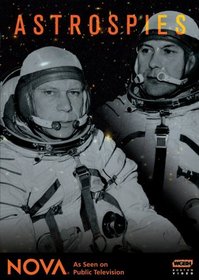| Actor: Nova Director: Nova Genres: Educational, Documentary Sub-Genres: Educational, Politics, Science & Technology Studio: WGBH Boston Format: DVD - Color DVD Release Date: 05/13/2008 Original Release Date: 01/01/2008 Theatrical Release Date: 00/00/2008 Release Year: 2008 Run Time: 0hr 56min Screens: Color Number of Discs: 1 SwapaDVD Credits: 1 Total Copies: 0 Members Wishing: 1 MPAA Rating: NR (Not Rated) Languages: English |
Search - Astrospies on DVD
  | Astrospies Actor: Nova Director: Nova Genres: Educational, Documentary NR 2008 0hr 56min Presents new information about the period during the Cold War when the U.S. and USSR were on the verge of war and attempting covert operations. |
Larger Image |
Movie DetailsSimilar Movies
|
Movie ReviewsAstrospies (2007)-Very fine and informative DVD by NOVA! Keith Mirenberg | www.spaceanimations.org | 08/18/2009 (5 out of 5 stars) "I really enjoyed this well done NOVA space special which documented parallel efforts by the United States and Soviet Union to develop manned space stations dedicated to photographic intelligence gathering. Both were started and ultimately abandoned in favor of unmanned satellites which were Eisenhower's preferred method of achieving this end for the least cost. I consider myself a space historian wanna be, and I never heard about these details until seeing this very informative and interesting NOVA special. In the US the program was called the Manned Orbiting Labratory (MOL) and a project of the U.S. Air Force. In the USSR the station was named ALMAZ. The MOL only progressed to the single launching of a boiler plate station and a modified Gemini two man vehicle which was successfully recovered. ALMAZ test results went further with the launching of the Soviet station, but ultimately abandoned. Had we proceeded with MOL our Air Force would have gained some direct experience in manned space flight operations years before the space shuttle as well as valuable intelligence which was at the time vital to our defense. It is sad that this early visionary space project, as well as the X-20 space glider which was another Air Force space project, were both cancelled." Star Wars Mr. Richard D. Coreno | Berea, Ohio USA | 08/01/2009 (5 out of 5 stars) ""On February 25, 1977, at 9:21 a.m., Moscow time, Colonel Gorbatko undocked from Almaz and descended toward central Kazakhstan. He and his partner would be the last astrospies. After 13 years of extraordinary effort by scientists from both sides, with billions of rubles and billions of dollars spent, only five missions had been launched, all by the Russians. And just two of those were deemed a success. For all the effort, astrospies had managed just 81 days in orbit," says the narrator in the closing minutes of this incredible documentary on spies taking their craft into the final frontier.
In the 1960s, the United States and Soviet Union began forging parallel trails to design military space stations to conduct surveillance and reconnaissance of Earth; the United States Manuel Orbiting Laboratory (MOL) and the Soviet Almaz program. Though there had been several magazine articles in the 1980s and 1990s on this little-known space race, the NOVA program is the first to explore it on television. The timeline is hazy in parts - documents remain classified in the U.S. and Russia - but interviews with historian/author/co-producer James Bramford, a number of military astronauts selected for MOL, Almaz cosmonauts and Almaz designers, along with never before seen footage, provide an outstanding overview and details on both space stations. MOL was canceled before it could fly and Almaz flew several times before the Soviet's ended the project. One fascinating fact is the Almaz was equipped with a cannon to destroy satellites or attack American astrospies and was test-fired in space. There are triumphs, tragedies and political squabbles - the debate in both governments was surprisingly similar - with essentially the same conclusions drawn, but about a decade apart. Until the full story can truly be told, the documentary will stand as a fascinating look into the merging of science and spycraft in the great game to heat up space during the Cold War. " |





